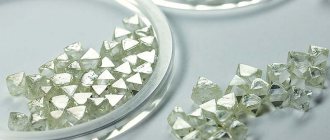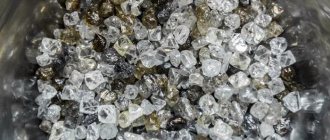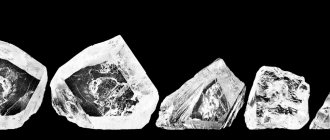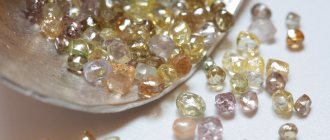Diamonds are mined especially actively in Africa. This is explained by the fact that many inactive volcanoes are located on this unique continent.
For reference: a diamond is a rock that several thousand years ago could have looked like ordinary graphite.
Over a long period of time, the graphite was compressed under pressure, it was influenced by enormous temperatures (about 1000 degrees), and it was located at a depth of at least 100 kilometers.
But how were people able to get diamonds? It's simple - volcanoes, erupting with huge amounts of lava, take with them a lot of diamonds, which can then be mined on the surface.
Of course, the volcano must have been inactive for a long time.
Graphite is an ordinary material that is not particularly valuable. When it changes, the structure becomes strong and hard, which is how diamonds are formed.
History and geography of diamond mining in Africa
The Orange River is where diamonds were first discovered in Africa.
Before this, diamonds were supplied by India, Australia, Brazil and many others.
Diamonds became cheaper and more expensive, depleted and found again.
Now, due to the fact that many sources have already been depleted, and the formation of African diamonds takes a lot of time and, possibly, several natural disasters, this stone is considered one of the most valuable.
In Africa, pure diamonds are found that are not too expensive, and ordinary African tribes are engaged in mining.
Diamond deposits in Africa began to be explored in 1867. They are still found on the coast of the Orange River.
The richest places in Africa for diamonds are the Kimberley and De Beers regions. Here you can find large diamonds, as well as small coins, which are also not cheap.
The history of diamond mining in Africa began not without the presence of Europe. So, since at the time of the discovery of African diamond deposits, Britain was in charge of many territories, African jewelry was sent there.
In 1912, entire placers of volcanic rock were found in eastern Africa, which contained many diamonds. They have not been fully processed to this day.
Today, it is the southern part of Africa that is considered the leader in diamond deposits, but Brazil occupies the second place of honor, although it was once in the first position.
African diamonds are found even in Lisotho, and they are very large and pure.
They are considered the most expensive in the world. For example, the largest crystal is 215 carats; no one has ever found a larger one in the whole world.
Interesting: the most expensive diamond (215 carats) costs $8 million.
Another place of active diamond mining in Africa is Angola. Representatives of international organizations who work using modern equipment are concentrated here.
Among the abandoned diamond deposits in Africa, which have not yet been touched by specialists:
- Sierra Leone;
- Tanzania;
- central Africa (scientists have not reached these places, but it is assumed that many diamonds are buried here).
The poorest empire in the history of the planet
Soon after the overthrow of his uncle, Jean began to act so wildly that even the Ugandan Idi Amin hiccupped with envy. The main goal was to extract money from great and not so great powers to support themselves.
After this, there was practically nothing left for the empire - there was only one dentist in the whole country.
For the sake of Gaddafi's money, Bokassa converted to Islam and instead of Jean became a solid Salah-ed-din Ahmed, which did not stop him from gorging himself on traditional delicacies from political opponents and personally torturing oppositionists.
After several attempts by the French intelligence services to eliminate the clearly not very sane ruler, he took the hint and granted the former metropolis most favored nation treatment - especially in the sense of mining useful uranium for the economy. Bokassa immediately proved to be the best friend of President Valéry Giscard d'Estaing and practically a bastion of African democracy. The French leader visited the Central African Empire on several occasions for safaris. Whether he ate the best delicacies of the imperial cuisine at the same time remains, alas, behind the scenes.
Valéry Giscard d'Estaing and Bokassa
When the emperor finally went and began to shoot schoolchildren, and the completely starved people began to openly demonstrate their desire to elevate their adored monarch even more (and it makes no difference, on a lantern or on a pitchfork), in Paris they decided to promptly lead the process of democratic reforms. However, the suffering of civilians was only a secondary reason against the backdrop of a much more terrible one for Paris. Thirsting for even more money, Bokassa tried not only to deprive the French of uranium, but also to sell it to the terrible dictator Gaddafi to create something not very good from the point of view of the nuclear non-proliferation regime.
While Bokassa once again went to ask for coins from Gaddafi, brave French paratroopers from among the well-not-colonial Marine troops suddenly appeared on the “transals” in Bangui and dispersed the entire shop with their very appearance. And then they returned Bokassa’s beloved uncle and the unwisely uneaten David Dako to the presidency.
The Soviet Ministry of Foreign Affairs, which had not given up hope of changing Bokassa’s orientation to socialist, became ritually indignant. And their colleagues from the Quai d'Orsay made one of the best French jokes of the century, proudly declaring the operation "the last colonial expedition of France." The last one is like a Chinese warning, yes, yes...
But after the exemplary overthrow of Bokassa, little has changed for the better in the country.
African diamond prices
Plunging, again, into the history of diamond mining, it was the British who began to develop the deposits.
They kept statistics on the extraction of this natural material. Thus, the latest accurate data were published relatively long ago - in 2004.
Today the situation could change, but only in the direction of growth and expansion of the geography of diamond production.
The cost data for African diamonds are as follows:
- Botswana - almost 3 billion dollars;
- South Africa – $1.3 billion;
- Angola – $1.2 billion;
- Namibia – $0.8 billion.
Anti-balaka vs Seleka
When the patience of the local residents ran out, the Anti-Balaka movement arose. That is, the “anti-machete” - it was with the help of this weapon that Seleka militants massacred local Christian residents.
At first, the Anti-Balaka had almost no weapons. It included local residents who were categorically fed up with the role of victims of the raiders. True, it was dangerous to slaughter armed Seleka militants. Therefore, the Anti-Balaka focused mainly on peaceful Muslim neighbors who had nothing to do with Seleka. At the same time, we remembered the centuries-old traditions of defense against slave traders, and the inevitable conflicts in the Sahel zone between settled Christian tribes and Muslim pastoralists, who have completely different views on the agricultural development of the same lands...
Anti-Balaka fighters
The traditional Central African amusement of “gangs of raiders running around the country and trying to overthrow each other” quickly gave way to a sadder interfaith conflict: Christians against Muslims. The world media was full of headlines: in some, the Seleka were presented not just as gangs of raiders, but as “Islamist terrorists cutting off the heads of Christians purely in the name of jihad”; in others, the Anti-Balaka turned from a mixture of self-defense units with crowds of rioters into “Islamophobic crusaders committing genocide of Muslims.”
Reitz
This diamond was found at the end of 1895 at the Jagersfontein mine. The diamond was an irregularly shaped octahedron that had no clear edges. The Reitz diamond weighed 650.8 metric carats. The diamond received its name in honor of the President of the Orange Republic, F.W. Reitz. In 1897, the diamond was made into two diamonds, one large weighing 245.35 metric carats, and the second a smaller diamond-shaped diamond weighing 13.34 metric carats. The large diamond was named Jubilee in honor of Queen Victoria's sixty-year reign. In 1900, the Jubilee diamond was demonstrated at the Paris Exhibition. Then the Jubilee diamond changed several owners and ended up with Paul Louis Veiller, who put it on display at the Smithsonian Institution in Washington.
Relevant products in the Online store:
I`m Sorry For My Skin
Jelly Mask Pore Care Fabric-gel mask for narrowing pores Forgive me, my skin! for sweets
from RUB 2,546
I`m Sorry For My Skin
Sheet-gel mask for narrowing pores in a glass “Forgive me, my skin!” for sweets
999 rub.
sale
I`m Sorry For My Skin
Jelly Mask Pore Care Fabric-gel mask for narrowing pores Forgive me, my skin! for sweets in disposable packaging
249 rub.
best-seller
Lancome
Absolue Sheet cream face masks
RUB 8,062 RUB 10,750
All goods
TOP 10 countries in Africa rich in mineral resources
Botswana
Diamond deposits were first discovered in the country in the late sixties of the last century. Since then, diamonds have been the country's main export, bringing in up to seventy percent of total income and ensuring stable annual economic growth.
In addition to diamonds, lithium and chromite are mined in the country.
Gabon
The Republic of Gabon is rich in “black gold”. The oil produced here is exported to China and Japan, and its sales bring in seventy percent of the country's total income.
In addition, the subsoil of the state is rich in manganese and uranium ores, and natural gas is also produced here.
South African Republic
South Africa is one of the most developed countries on the continent. Stable development is ensured largely by the presence of significant reserves of natural resources. Mined here:
- manganese;
- gold;
- platinum;
- coal;
- diamonds;
- Uranus;
- asbestos.
In addition, there are significant reserves of iron and chromite ores. Such an abundance of mineral resources allows the country to occupy a leading place among the countries of both its continent and the whole world.
Nigeria
The first sources of oil were discovered in the country at the beginning of the twentieth century. Since then, “black gold” has been the main export item of the state. The country ranks sixth in the world in terms of the volume of exported raw materials. In addition to oil, the country exports tin.
Egypt
Rich in its recreational resources, the country also boasts significant deposits of natural gas and oil. Every year, the export of these natural resources brings the country more than twenty billion dollars.
The main buyers of Egyptian oil and gas are Italy, the United States of America and the United Arab Emirates.
Ghana
Ghana is a country where a large number of different types of natural resources are concentrated. Natural gas and oil, silver and bauxite are mined here. Gold is mined on an industrial scale - the country is one of the top ten exporters of this metal.
Tunisia
The country, considered by many to be a paradise for tourists, has the largest deposits of phosphorites on the continent. Their reserves amount to more than one billion tons.
The country's subsoil also contains reserves of oil and natural gas, iron ore, mercury, lead, zinc and barite.
Libya
Libya has the continent's richest oil and gas reserves. Due to the tense situation within the country, the production of mineral raw materials has decreased sharply, but even in such conditions, the export of these minerals brings the country more than sixty-four billion dollars a year.
Congo
The Congolese state receives its main income from trade in oil and natural gas. In terms of oil production, the country ranks eighth in the region.
Angola
Angola is another country that has huge oil reserves. The sale of this mineral raw material provides the country with eighty-five percent of all income received.
In general, up to twelve percent of all natural resource deposits in the world are concentrated on the continent, which creates significant prerequisites for the economic development of the states located here.
The richest countries in Africa
The mere presence of a sufficient amount of natural resources does not determine the wealth of a country.
This indicator is also influenced by such criteria as the volume of gross domestic product, the level of development of the state, which is determined by a number of criteria, such as:
- volume of gross domestic product per capita;
- level of social protection of the population;
- general educational level in the country;
- the prevalence of service sectors over other sectors of the national economy;
- the degree of development of market relations in the state;
- the level of unemployment and the degree of employment of the population in sectors of the economy and others.
It is on the basis of all the above indicators and criteria that one can determine which African countries can be called the richest.
Africa: subsoil rich in minerals
The African continent is rich in its natural conditions, significant mineral reserves, as well as plant, land and water resources.
It is this continent that accounts for about seventeen percent of the world's timber reserves, which is the main export item for many of the countries located here.
The extensive river system provides many states with energy resources. Among the mineral raw materials, it is worth noting the richest deposits of tantalum, titanium, chromites, bauxites, phosphorites, gold, diamonds and rare earth metals.
There are huge reserves of uranium, cobalt, manganese and copper ores.
Inventories are unevenly distributed. Thus, gas and oil are produced in Libya, Egypt, Nigeria and Algeria. Ores rich in cobalt and copper are mined in Congo and Zambia, and Zimbabwe and South Africa are rich in manganese ores.
In addition, South Africa is a leader in the mining of gold, platinum and iron ores. Diamonds are mined in industrial quantities in Angola, Botswana, Congo, Namibia and South Africa. The leaders in uranium mining are Niger and Namibia.
The rating below will tell you which countries boast the largest reserves of natural resources.
Cullinan VI
Cullinan VI weighs 11.50 carats and is marquise cut. King Edward VII presented it to his wife, Queen Alexandra, as a personal gift. Queen Alexandra adorned her tiara with a diamond. In 1925, the diamond was inherited by Queen Mary. Well versed in gemstones, Queen Mary decided that the Cullinan VI would look great as a pendant on a platinum and diamond brooch, which featured the 6.8-carat Cullinan VIII diamond as the centerpiece. Since then, this decoration has been called the “Cullinan VI & VIII Brooch”.
0
Cullinan VIII
Cullinan VIII weighs 6.8 carats and has a cut close to the emerald type. In 1911, Garrard set the diamond in a platinum base similar in style to the Cullinan V brooch. In 1925, the Cullinan VI was added as a pendant and the jewel acquired its current name, the Cullinan VI & VIII Brooch. However, the Cullinan VIII diamond can be removed from the brooch and become part of the bodice decoration of the Delhi Durbar parure or attached to the Cullinan V brooch.
Cullinan V
The Cullinan V diamond has a triangular pear-shaped or heart-shaped cut and weighs 18.80 carats. The gemstone is the central part of the brooch, made of platinum and surrounded by smaller diamonds. The brooch was made in such a way that it could be worn alone or mounted on Queen Mary's crown instead of the Koh-i-Noor. In addition, the brooch was part of the famous Delhi Durbar parure, made of emeralds and diamonds for Queen Mary in 1911.
0
Cullinan III and Cullinan IV
The Cullinan III diamond is pear-cut and weighs 94.40 carats. The stone was set on top of the crown of Queen Mary, wife of King George V. The crown was made by the court jewelry firm Garrard & Co for Mary on the occasion of her husband's coronation, which took place on June 22, 1911. In addition to the Cullinan III, the crown also featured the Cullinan IV diamond, and the centerpiece was the famous Koh-i-Noor diamond. After the coronation ceremony, the diamonds in the crown were replaced with quartz replicas, and the precious stones began to be used in other jewelry. As a result, the Cullinan III and Cullinan IV diamonds were combined to make a brooch pendant. Queen Mary was famous for her love of jewelry, and this diamond pendant was one of her favorites. The Cullinan IV is cushion cut and weighs 63.60 carats.
0
Cullinan I
The Cullinan I or "Great Star of Africa" is the largest of all the diamonds produced by cutting the Cullinan diamond. It weighs 530.20 carats and is pear-shaped with 76 facets. By order of King Edward VII, the diamond was mounted in the top of the royal scepter, which is currently on display in the Tower of London.
0
How diamonds rise to the surface of the Earth
Let us assume that at a depth of 150-200 km in the lithosphere (the upper part of the “solid” Earth) during the Archean period a 50-kilometer layer of diamond-bearing rocks was formed. And after about 2 billion years, a plume (ultra-deep magma that rises to the base (lower boundary) of the lithosphere) formed at the boundary of the earth’s core and the lower mantle. The melts that make up the plume rise in a spiral vertically to the Earth's surface and can even reach it. A plume that reaches the base of a cold, stable lithosphere causes partial melting of matter in its lower levels and, as a rule, brings with it more oxygen than the “diamond hunters” would like. Kimberlite melts
are formed at extremely low degrees of partial melting (1.5-3.0 vol. %) of depleted ultrabasic rocks of the lithospheric mantle, which shortly before melting were enriched to varying degrees in fusible components.
These melts have low viscosity, form a thin film of intergranular space, and can percolate and form relatively small pockets of kimberlite magma. During the period of tectonic activation, certain deep faults of kimberlite-generating zones of ancient platforms, connecting such centers with the earth's surface, serve as channels for the extremely rapid rise (in the first hours) of kimberlite melts to the earth's surface. The layer of rocks enriched with diamonds is located at a depth of more than 150 km.
At the same time, the formation of magmatic melts under continents in most cases occurs at shallower depths (100 km or less). The exception is magmas associated with mantle plumes and superplumes, which rise from great depths, originating at the boundary of the core and mantle. The largest outbreaks of magmatism in the history of the Earth are associated with these phenomena. First of all, this is the formation of trap provinces - giant lava plateaus - where, over the course of 1-2 million years, millions of cubic meters of mantle lava poured onto the earth’s surface (to understand the scale of this phenomenon, let’s just say that the total volume of all buildings and structures created by mankind over the entire history of its existence, does not reach 100 (!) m3) The majority (95%) of diamond deposits are associated with kimberlite melts, which rise along cracks and “along the way” crush diamond-bearing rocks, carrying diamonds and fragments of rocks of the ancient lithospheric mantle from the mantle depths.
We can say that kimberlite pipes are ancient volcanoes that play the role of transporters that carry mantle rocks and minerals, including diamonds, to the earth's surface. Remember how the water carries various debris, small flakes of gold that are washed out of the banks. In the situation we are considering, the “stream” flows not along the surface, but from the depths of the earth, subvertically to the surface of the Earth. This is magma that rises rapidly under great pressure. The viscosity of kimberlite melt is comparable to the viscosity of oil that is poured into a car engine. And the speed of its rise up under pressure is also comparable to the speed of a car (approximately 60-70 km/h). In two to three hours it covers the entire distance from the place of melt formation to the earth's surface. In this case, the diamond does not have time to graphitize.
If the melt moves slowly, with stops at mantle depths, but already in the region of thermodynamic stability of graphite (i.e., at depths less than 140 km), then the diamond will be able to rearrange its crystal lattice and turn into graphite, and in the case of a relatively high oxygen potential in a melt it will simply burn.
At a depth of 4-5 km from the earth's surface, kimberlite magma, containing many volatile components (CO2 and H2O), begins to boil. As an example, let's look at the operating principle of a pressure cooker. It has a lot of pressure, and therefore the temperature at which water boils in a closed pressure cooker may not be 100 °C, but 120-140 °C, and even higher. However, if you open the lid, the steam will suddenly escape (it will look like an explosion) and the temperature will very quickly drop to 100 ° C (this is the boiling point of water at 1 atm.).
When kimberlite magma (and not only kimberlite) boils, an explosion also occurs and explosion tubes are formed, which are instantly filled with magma; the temperature drops very quickly. In the North, in the breccias of the vent parts of kimberlite pipes, fragments of Mesozoic wood can be found, which did not burn because the temperature dropped very quickly; This Mesozoic wood can be used to light a fire.
So, if a rapidly rising flow of kimberlite magma crosses a layer of diamond-bearing rocks, a diamond-bearing pipe is formed.
If the magma flow crosses relatively shallow levels of the mantle, where pressures correspond to the region of graphite stability, then a tube will form that does not contain diamonds at all.
In order to understand how diamonds are found, it is necessary to look “from the outside” at the process of bringing diamonds to the surface. By what signs do geologists who have chosen a potentially diamond-bearing area determine that the search is worth continuing? How exactly is diamond search carried out?
After the map has shown a supposedly promising area and aeromagnetic survey has revealed structures with magnetic anomalies, the stage of more detailed searches begins. Geologists conduct spot sampling of channel deposits of the river system, if there is one. For exploration areas in northern Canada, glacial deposits are more often sampled. At this stage, it is important to detect kimberlite indicator minerals in the samples: pyropes, picroilmenites, chromites, chrome diopsides and, if you are very lucky, diamonds. The presence of these minerals in the samples is direct evidence of the presence of kimberlites in the region and, if the samples contain diamonds, diamond-bearing kimberlites. A tray is traditionally used to search for indicator minerals in Siberia. If at the bottom of the tray geologists see indicator minerals, and possibly diamond crystals, then the initial stage of the work has been successful. After this, the stage of more detailed, labor-intensive and order of magnitude more expensive searches begins using a set of geophysical methods, including both aerial and ground surveys, verification of the obtained geophysical anomalies by dense spot sampling, followed by drilling out the most promising of them.
Let's assume that kimberlite is found. The goal of the next stage of the search is to outline the contours of the tube. To do this, you will need to go through several more pits or drill several wells along the body of the pipe and compare the data obtained with the configuration of geophysical anomalies. Then you need to answer the main question: is the discovered pipe diamond-bearing? This question is far from idle, considering that out of almost a thousand kimberlite pipes of the Yakut diamond-bearing province, less than fifty have increased diamond content and only fifteen of them have industrial diamond content.
In the late 60s - early 70s. XX century The outstanding Russian mineralogist (now Academician of the Russian Academy of Sciences) Nikolai Vladimirovich Sobolev, having carried out a comparative analysis of the results of his study of the composition of crystalline inclusions in natural diamonds, for the first time in world practice developed mineralogical criteria for the diamond potential of kimberlites. Based on these criteria, the team of Siberian geologists he led created a set of fundamentally new mineralogical methods, which at the early stages of prospecting work make it possible to assess the potential diamond content of yet undiscovered kimberlites based on the composition of indicator minerals, primarily pyropes and chromites.
It is not always possible to extract a representative amount (the first hundreds of grains) of indicator minerals and, based on their composition, to evaluate the potential diamond content of the predicted pipe, since kimberlites can be completely different.
For example, in the Mir pipe, 1 ton of kimberlite contains about 20 kg of indicator minerals, including more than 5 kg of chromium-containing pyropes. Such kimberlite pipes provide a powerful plume that makes it possible to detect the pipe itself. Moving along the river, the geologist can always see the pyropes “under his feet” and, “following the trail,” go to the pipe. In contrast to this situation, in the anomalous kimberlites of the Nakyn field pipes (Yakutia) and the dike complex
Snap Lake (Canada) the content of indicator minerals per 1 ton of substance is almost 100 times less (that is, 200-300 g/t), although these kimberlites are distinguished by a very high diamond content.
When searching for a handset, you may encounter other problems. Pipes whose kimberlites contain an increased amount of magnetic minerals (magnetite, titanomagnetite, etc.) are recorded by geophysical methods because they give a magnetic anomaly. However, there are kimberlites that contain very few magnetic minerals, and magnetic surveying alone is not enough to detect them.









